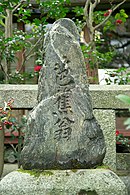Manju-ji (Iga)
The Manju-ji ( Japanese 萬壽寺 ) is a temple of the Sōtō direction of Buddhism in the city of Iga in Mie Prefecture .
history
The forerunner, the Chōfuku-ji (長 福寺), was a sub-temple (末 寺; Matsuji) of the Saidai-ji , which was built as a prayer temple in the 13th century at the request of the Fukuchi princes (福地 氏). In 1760 it was renamed Manju-ji.
The attachment
The simple system consists of buildings around a courtyard. You enter it through the not very large temple gate (山門, Sanmon; 1) and then have the main hall (本 堂, Hondō; 2) in front of you. In the main hall there is a cabinet (桃 青 堂, Tōsei-dō) with a statue of the poet Matsuo Bashōs , who comes from Iga. On the left is the small Kannonhalle (観 音 堂; 3), the oldest building in Mie Prefecture, and on the right the abbot and monk's quarters (A) and the cemetery (F) where Bashō was buried.
Treasures of the temple
The main cult figure, a seated, wooden, life-extending holy Jizō (木造 延命 地 蔵 菩薩 坐像, Mokuzō emmei Jizō bosatsu zazō) from the 3rd year Jōji (1364) was registered in 1936 as an important cultural asset of Japan . It is signed inside, contained a shari and a number of texts and numerous additions. The temple also has a standing holy Fudō Myōō (木造 不 動 明 王立 像, Mokuzō Fudō Myōō tatsuzō) - cultural property of the prefecture - and numerous other temple treasures.
Remarks
- ↑ Shari (舎 利) is a relic, an (assumed) piece of bone of Buddha.
literature
- Mie-ken kotogakko Nihon rekishi kenkyukai (Ed.): Manju-ji . In: Mie-ken no rekishi sampo. Yamakawa Shuppan, 2007. ISBN 978-4-634-24624-9 . P. 222.
Web links
- Temple website (Japanese)
Coordinates: 34 ° 50 ′ 11.8 " N , 136 ° 14 ′ 43.1" E

